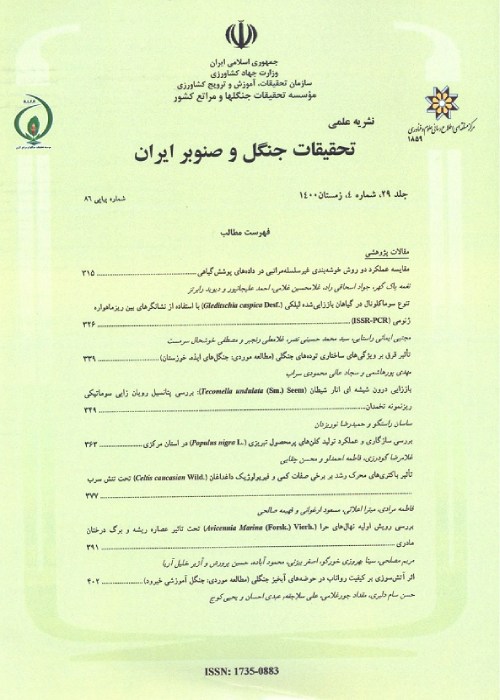Investigating the different models of diameter distribution for Populus deltoides plantation in relation to planting distances
Author(s):
Article Type:
Research/Original Article (دارای رتبه معتبر)
Abstract:
The number of trees in each diameter at the breast height (DBH) class is considered the diameter distribution model and it is one of the most critical parameters in describing the structure of the stands. The diameter distribution of trees is one of the most important aspects that should be considered by forest managers when deciding on forest management strategies. This study aimed to investigate the diameter distribution functions of poplar (Populus deltoides) trees in the plantation in the Guilan province under the influence of different planting distances. To use models of diameter distribution functions as a tool to obtain reliable information about the structure, growth, and performance of plantations, and to manage silvicultural treatments in these stands. For this purpose, the measurement of all trees’ DBH in the one hectare plots was used in five pure poplar plantations with 5×5 m, 3×5 m, 3×3 m, 3.5×5 m, and 3×4 m planting distance. Kolmogorov-Smirnov fitting test showed a specific distribution function in each stand. The diameter distribution of the trees followed the Beta function in the stand with a planting distance of 5×5 m. The diameter distribution function has of Log-Normal (3P) distribution at a planting distance of 3×5 m. The diameter distribution of trees was a Normal function at a planting distance of 3×3 m, at a planting distance of 3.5×5 m in the fourth stand, the diameter distribution of the trees was fitted as a Weibull function and Normal distribution was shown in 3×4 m planting distance in the last stand. The present study showed that planting distance on the plantation is a factor in changing the diameter distribution functions. At less planting distance, the diameter distribution of trees was normal, and by increasing the planting distance, various diameter distributions were obtained in the stands. Therefore, the present research can be used as a reference study by introducing the diameter distribution model for a mono-culture homogeneous pure stand regarding planting distance. This is practical for stand management to reach a desired distribution or management to transform from a pure stand to a mixed species stand by combining several species with appropriate distribution. In addition, transitioning from a single species structure to a diverse structure using growth performance models is required to simulate this stand's dynamics, the initial step is the determination of the tree’s diameter distribution models as a basic study.
Keywords:
Language:
Persian
Published:
Iranian Journal of Forest and Poplar Research, Volume:30 Issue: 2, 2022
Pages:
193 to 210
magiran.com/p2501566
دانلود و مطالعه متن این مقاله با یکی از روشهای زیر امکان پذیر است:
اشتراک شخصی
با عضویت و پرداخت آنلاین حق اشتراک یکساله به مبلغ 1,390,000ريال میتوانید 70 عنوان مطلب دانلود کنید!
اشتراک سازمانی
به کتابخانه دانشگاه یا محل کار خود پیشنهاد کنید تا اشتراک سازمانی این پایگاه را برای دسترسی نامحدود همه کاربران به متن مطالب تهیه نمایند!
توجه!
- حق عضویت دریافتی صرف حمایت از نشریات عضو و نگهداری، تکمیل و توسعه مگیران میشود.
- پرداخت حق اشتراک و دانلود مقالات اجازه بازنشر آن در سایر رسانههای چاپی و دیجیتال را به کاربر نمیدهد.
In order to view content subscription is required
Personal subscription
Subscribe magiran.com for 70 € euros via PayPal and download 70 articles during a year.
Organization subscription
Please contact us to subscribe your university or library for unlimited access!


